Ecologically Intermediate and Economically Final: The Role of the Ecosystem Services Framework in Measuring Sustainability in Agri-Food Systems
Abstract
:1. Introduction
- The Millennium Ecosystem Assessment [8] defines ESs as benefits people obtain from ecosystems. There are four groups of services (provisioning, regulating, supporting, and cultural), and one group of these services (supporting) is intermediate to the others;
- The Economics of Ecosystems and Biodiversity [9] defines ESs as the direct and indirect contributions of ecosystems to human wellbeing. There are four groups of ESs (provisioning, regulating, habitat, and cultural) that are all considered as final with respect to use and non-use values expressed by economy and society;
- The Common International Classification of Ecosystem Services (CICES) [10] defines ESs as the contributions that ecosystems make to human wellbeing, and as distinct from the goods and benefits that people subsequently derive from them. There are three groups of services (provision, regulation and maintenance, and cultural) set for multidisciplinary uses. Some of them can be considered intermediate or final, depending on the context.
2. Methods: How to Consider Intermediate and Final Services in Assessing Crop Provision
- The first approach, where soil retention is treated as an intermediate service;
- The third approach, where soil retention is treated as a final service.
3. Results: From Theory to Practice with a Concrete Application
- On-site soil retention plays a very important role in overall crop provision, accounting for ~45% of the total ES flow (EUR 9388/year of a total EUR 20,795/year in 2012);
- The calculation of on-site soil retention as a final ES flow is consistent with the previous crop provision calculation. Higher values of soil retention (EUR 11,407 in 2012) compared to crop provision (EUR 9388 in 2012) can be explained by the fact that crop provision only included arable crops, while on-site soil retention was also calculated for permanent crops.
4. Discussion
- Assess the sustainability of management practices (e.g., use of human inputs such as chemicals and machinery) in agriculture—the more ecological inputs (compared to human inputs), the more the agricultural system is connected with natural conditions and, thus, resilient to changes in these conditions;
- Measure whether the current protective role of vegetation is able to reduce soil erosion rates and prevent land degradation—where the soil formation rate is greater than the soil erosion rate, the protective role of the ecosystem can prevent degradation which, in turn, weaken the stability of the agricultural system;
- Determine the presence of habitats suitable to host wild pollinators, where there are pollinator-dependent crops—wild pollinator communities can simultaneously enhance crop yields and reduce exposure to changing environmental conditions.
5. Conclusions
Supplementary Materials
Funding
Data Availability Statement
Conflicts of Interest
References
- Van Zanten, B.T.; Verburg, P.; Espinosa, M.; Gomez-Y-Paloma, S.; Galimberti, G.; Kantelhardt, J.; Kapfer, M.; Lefebvre, M.; Manrique, R.; Piorr, A.; et al. European agricultural landscapes, common agricultural policy and ecosystem services: A review. Agron. Sustain. Dev. 2014, 34, 309–325. [Google Scholar] [CrossRef] [Green Version]
- Power, A.G. Ecosystem services and agriculture: Tradeoffs and synergies. Philos. Trans. R. Soc. Lond. B Biol. Sci. 2010, 365, 2959–2971. [Google Scholar] [CrossRef]
- Maes, J.; Teller, A.; Erhard, M.; Condé, S.; Vallecillo, S.; Barredo, J.I.; Paracchini, M.L.; Abdul Malak, D.; Trombetti, M.; Vigiak, O.; et al. Mapping and Assessment of Ecosystems and Their Services: An EU Ecosystem Assessment; Publications Office of the European Union: Ispra, Italy, 2020. [Google Scholar] [CrossRef]
- Garibaldi, L.A.; Andersson, G.; Requier, F.; Fijen, T.; Hipólito, J.; Kleijn, D.; Pérez-Méndez, N.; Rollin, O. Complementarity and synergisms among ecosystem services supporting crop yield. Glob. Food Secur. 2018, 17, 38–47. [Google Scholar] [CrossRef]
- Bethwell, C.; Burkhard, B.; Daedlow, K.; Sattler, C.; Reckling, M.; Zander, P. Towards an enhanced indication of provisioning ecosystem services in agro-ecosystems. Environ. Monit. Assess. 2021, 193, 1–37. [Google Scholar] [CrossRef]
- Therond, O.; Duru, M.; Roger-Estrade, J.; Richard, G. A new analytical framework of farming system and agriculture model diversities. A review. Agron. Sustain. Dev. 2017, 37, 21. [Google Scholar] [CrossRef]
- United Nations. System of Environmental-Economic Accounting—Ecosystem Accounting: Final Draft. 2021. Available online: https://seea.un.org/sites/seea.un.org/files/documents/EA/seea_ea_white_cover_final.pdf (accessed on 4 January 2022).
- Millennium Ecosystem Assessment. Ecosystems and Human Well-Being; Island Press: Washington, DC, USA, 2005. [Google Scholar]
- TEEB. Ecological and Economic Foundations; Kumar, P., Ed.; Earthscan: London, UK; Washington, DC, USA, 2010. [Google Scholar]
- Haines-Young, R.; Potschin, M. The links between biodiversity, ecosystem services and human well-being. In Ecosystem Ecology: A New Synthesis; Cambridge Univeristy Press: Cambridge, UK, 2012. [Google Scholar]
- Ouyang, Z.; Song, C.; Zheng, H.; Polasky, S.; Xiao, Y.; Bateman, I.J.; Liu, J.; Ruckelshaus, M.; Shi, F.; Xiao, Y.; et al. Using gross ecosystem product (GEP) to value nature in decision making. Proc. Natl. Acad. Sci. USA 2020, 117, 14593–14601. [Google Scholar] [CrossRef] [PubMed]
- Hein, L.; Remme, R.P.; Schenau, S.; Bogaart, P.W.; Lof, M.E.; Horlings, E. Ecosystem accounting in the Netherlands. Ecosyst. Serv. 2020, 44, 101118. [Google Scholar] [CrossRef]
- Vallecillo, S.; La Notte, A.; Ferrini, S.; Maes, J. How ecosystem services are changing: An accounting application at the EU level. Ecosyst. Serv. 2019, 40, 101044. [Google Scholar] [CrossRef] [PubMed]
- Perez-Soba, M.; Elbersen, B.; Braat, L.; Kempen, M.; van der Wijngaart, R.; Staritsky, I.; Rega, C.; Paracchini, M.L. The Emergy Perspective: Natural and Anthropic Energy Flows in Agricultural Biomass Production; Publications Office of the European Union: Luxembourg, 2019. [Google Scholar] [CrossRef]
- Hooper, D.U.; Chapin, F.S., III; Ewel, J.J.; Hector, A.; Inchausti, P.; Lavorel, S.; Lawton, J.H.; Lodge, D.M.; Loreau, M.; Naeem, S.; et al. Effects of biodiversity on ecosystem functioning: A consensus of current knowledge. Ecol. Monogr. 2005, 75, 3–35. [Google Scholar] [CrossRef]
- Potschin-Young, M.; Haines-Young, R.; Görg, C.; Heink, U.; Jax, K.; Schleyer, C. Understanding the role of conceptual frameworks: Reading the ecosystem service cascade. Ecosyst. Serv. 2018, 29, 428–440. [Google Scholar] [CrossRef] [PubMed]
- La Notte, A.; D’Amato, D.; Mäkinen, H.; Paracchini, M.L.; Liquete, C.; Egoh, B.; Geneletti, D.; Crossman, N. Ecosystem services classification: A systems ecology perspective of the cascade framework. Ecol. Indic. 2017, 74, 392–402. [Google Scholar] [CrossRef]
- Vysna, V.; Maes, J.; Petersen, J.; La Notte, A.; Vallecillo, S.; Aizpurua, N.; Ivits-Wasser, E.; Teller, A. Accounting for Ecosystems and Their Services in the European Union. Final Report from Phase II of the INCA Project Aiming to Develop a Pilot for an Integrated System of Ecosystem Accounts for the EU; Publications office of the European Union: Luxembourg, 2021. [Google Scholar] [CrossRef]
- La Notte, A.; Vallecillo, S.; Maes, J.; Shapiro, C.D.; Bagstad, K.J.; Ingram, J.C.; Glynn, P.D. Editorial special issue natural capital accounting: The content, the context, and the framework. Ecosyst. Serv. 2021, 51, 101347. [Google Scholar] [CrossRef]
- United Nations; European Union; Food and Agriculture Organization of the United Nations; Organisation for Economic Co-operation and Development; Word Bank Group. System of Environmental Economic Accounting 2012—Experimental Ecosystem Accounting; United Nations: New York, NY, USA, 2014; Available online: https://seea.un.org/sites/seea.un.org/files/seea_eea_final_en_1.pdf (accessed on 4 January 2022).
- Yuan, Z. Analysis of agricultural input-output based on Cobb–Douglas production function in Hebei Province, North China. Afr. J. Microbiol. Res. 2011, 5, 5916–5922. [Google Scholar]
- Imran, M.A.; Ali, A.; Ashfaq, M.; Hassan, S.; Culas, R.; Ma, C. Impact of Climate Smart Agriculture (CSA) Practices on Cotton Production and Livelihood of Farmers in Punjab, Pakistan. Sustainability 2018, 10, 2101. [Google Scholar] [CrossRef] [Green Version]
- Telldahl, C.; Hansson, H.; Emanuelson, U. Modelling animal health as a production factor in dairy production- a case of low somatic cell counts in Swedish dairy agriculture. Livest. Sci. 2019, 230, 103840. [Google Scholar] [CrossRef]
- Meja, M.; Alemu, B.; Shete, M. Total Factor Productivity of Major Crops in Southern Ethiopia: A Dis-Aggregated Analysis of the Growth Components. Sustainability 2021, 13, 3388. [Google Scholar] [CrossRef]
- Joachim, M.; Vallecillo, S.; La Notte, A.; Zurbaran, M.; INCA-Soil Retention. European Commission, Joint Research Cen-tre (JRC) [Dataset] PID. 2021. Available online: http://data.europa.eu/89h/2e120644-aee8-42f0-811a-c2bede08c604 (accessed on 30 November 2021).
- Duffy, M. Economies of Size in Production Agriculture. J. Hunger. Environ. Nutr. 2009, 4, 375–392. [Google Scholar] [CrossRef] [PubMed]
- Holland, J.M.; Douma, B.; Crowley, L.; James, L.; Kor, L.; Stevenson, D.R.; Smith, B. Semi-natural habitats support biological control, pollination and soil conservation in Europe. A review. Agron. Sustain. Dev. 2017, 37, 31. [Google Scholar] [CrossRef] [Green Version]
- Chaplin-Kramer, R.; O’Rourke, M.E.; Blitzer, E.J.; Kremen, C. A meta-analysis of crop pest and natural enemy response to landscape complexity. Ecol. Lett. 2011, 14, 922–932. [Google Scholar] [CrossRef]
- Meehan, T.D.; Werling, B.P.; Landis, D.A.; Gratton, C. Agricultural landscape simplification and insecticide use in the Midwestern United States. Proc. Natl. Acad. Sci. USA 2011, 108, 11500–11505. [Google Scholar] [CrossRef] [Green Version]
- Garibaldi, L.A.; Gemmill-Herren, B.; D’Annolfo, R.; Graeub, B.E.; Cunningham, S.A.; Breeze, T.D. Farming Approaches for Greater Biodiversity, Livelihoods, and Food Security. Trends Ecol. Evol. 2017, 32, 68–80. [Google Scholar] [CrossRef] [PubMed]
- Van Ruijven, J.; Berendse, F. Diversity enhances community recovery, but not resistance, after drought. J. Ecol. 2010, 98, 81–86. [Google Scholar] [CrossRef]
- Isbell, F.; Craven, D.; Connolly, J.; Loreau, M.; Schmid, B.; Beierkuhnlein, C.; Bezemer, M.; Bonin, C.; Bruelheide, H.; De Luca, E.; et al. Biodiversity increases the resistance of ecosystem productivity to climate extremes. Nat. Cell Biol. 2015, 526, 574–577. [Google Scholar] [CrossRef] [PubMed]
- Garibaldi, L.A.; Carvalheiro, L.G.; Vaissière, B.E.; Gemmill-Herren, B.; Hipólito, J.; Freitas, B.M.; Ngo, H.T.; Azzu, N.; Sáez, A.; Åström, J.; et al. Mutually beneficial pollinator diversity and crop yield outcomes in small and large farms. Science 2016, 351, 388–391. [Google Scholar] [CrossRef] [Green Version]
- Winfree, R.; Kremen, C. Are ecosystem services stabilized by differences among species? A test using crop pollination. Proc. R. Soc. B Boil. Sci. 2008, 276, 229–237. [Google Scholar] [CrossRef] [PubMed] [Green Version]
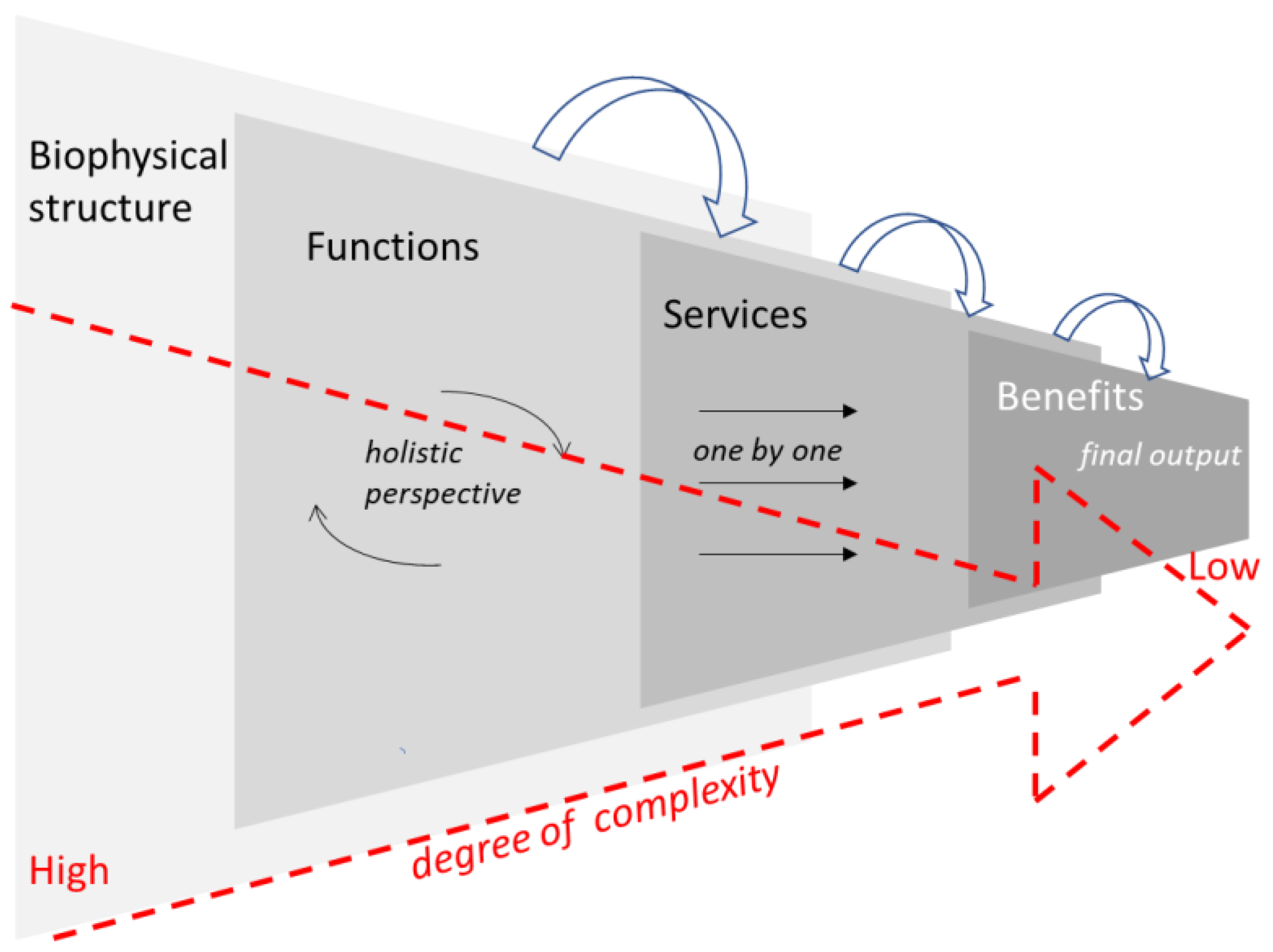
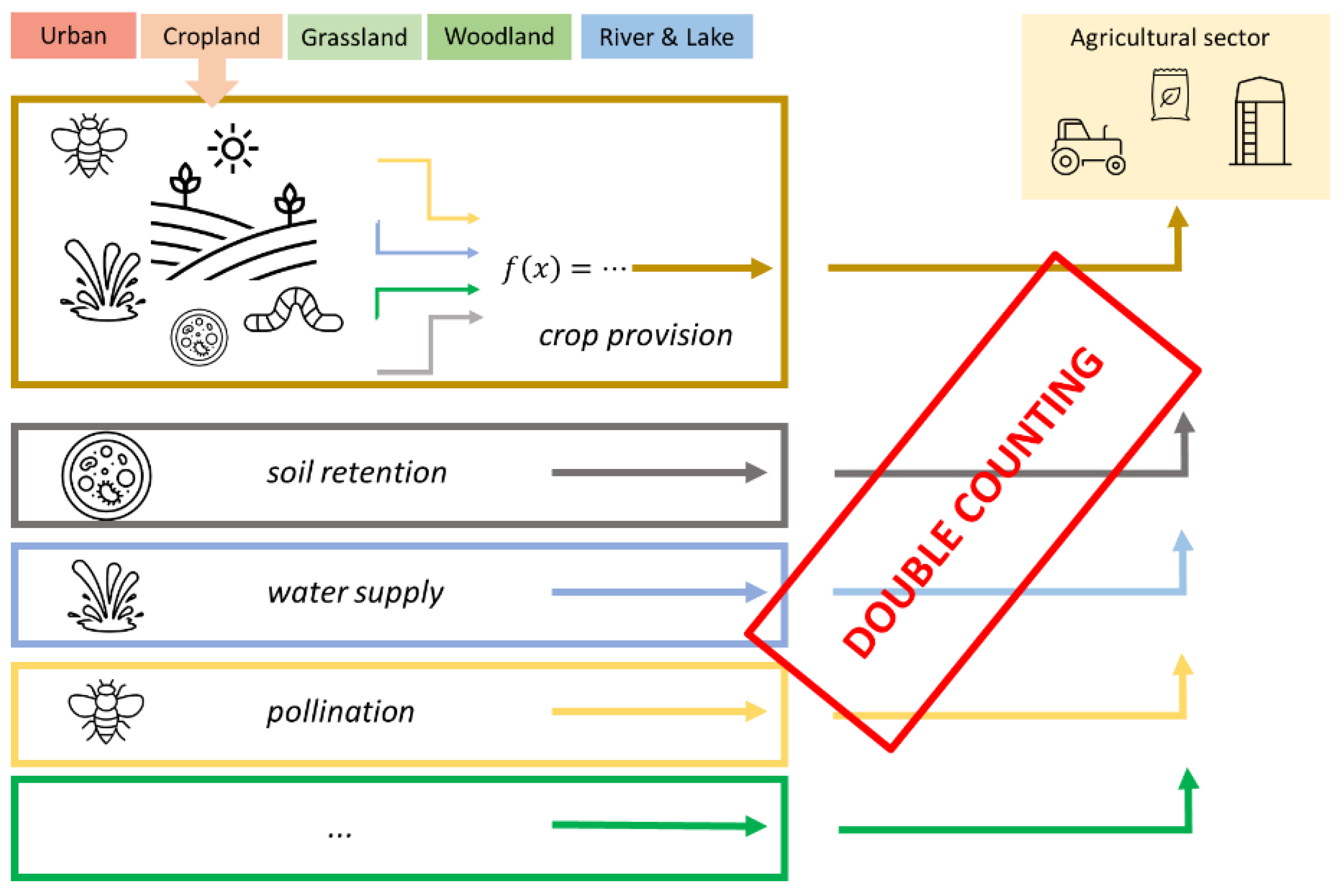
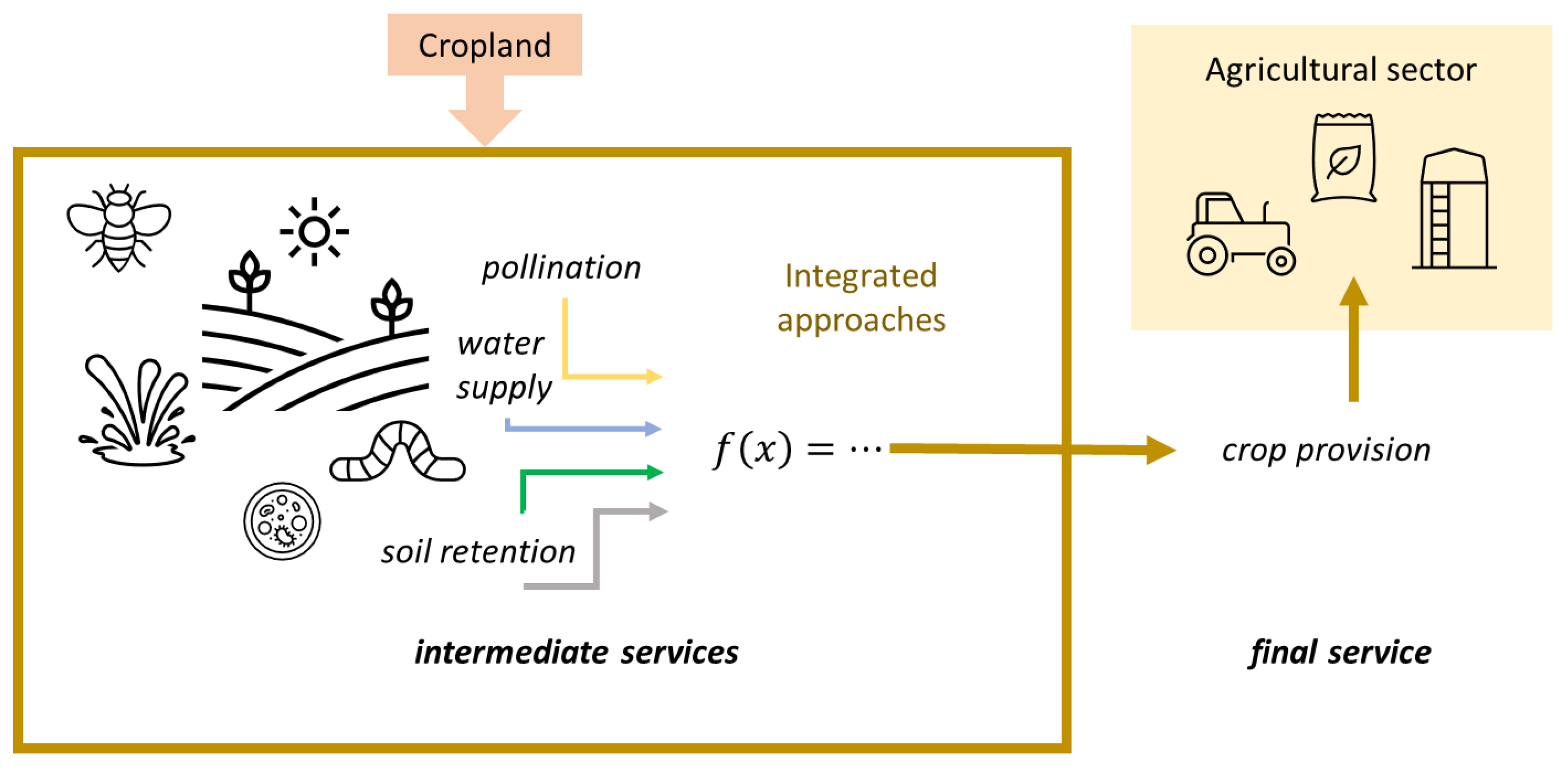
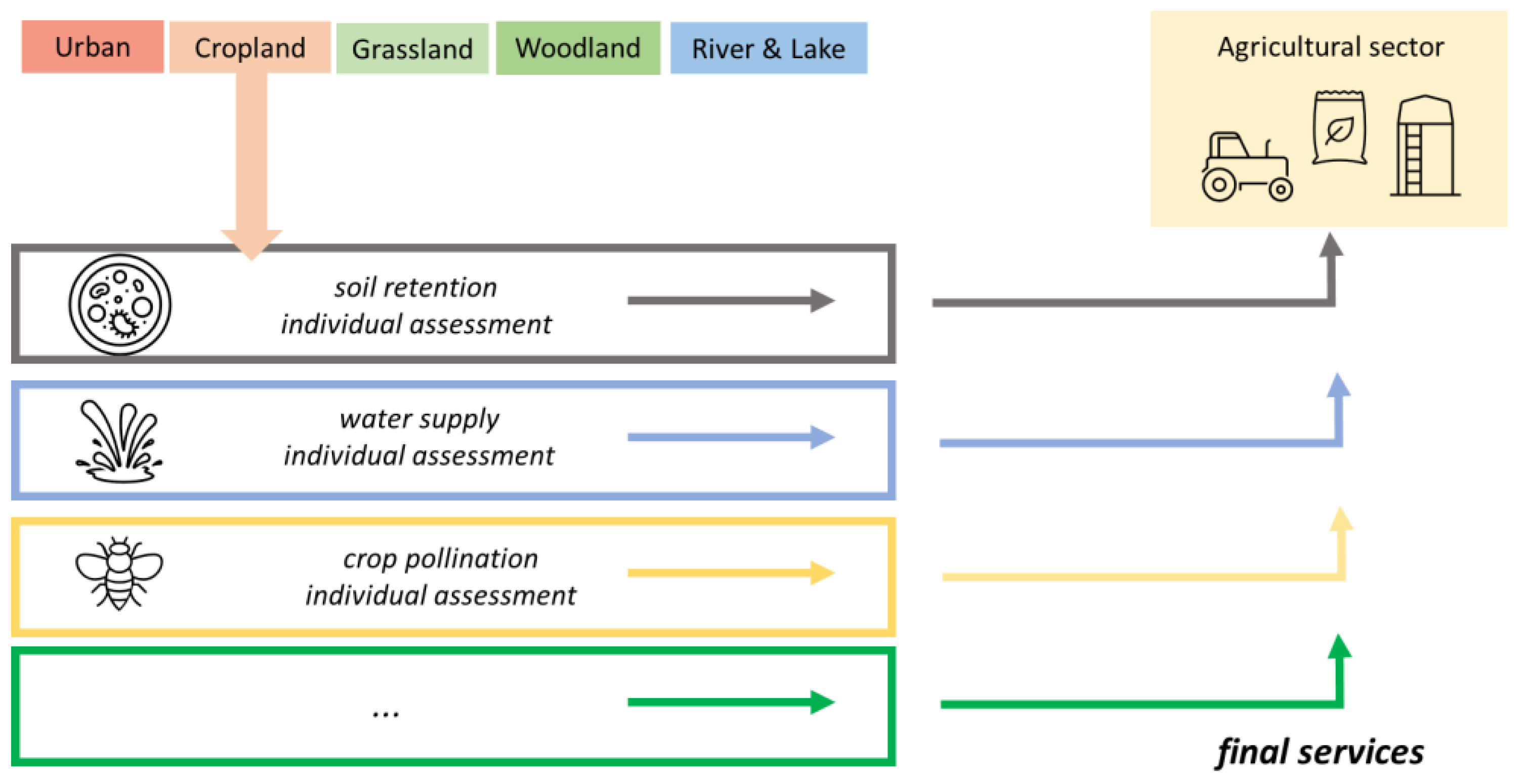
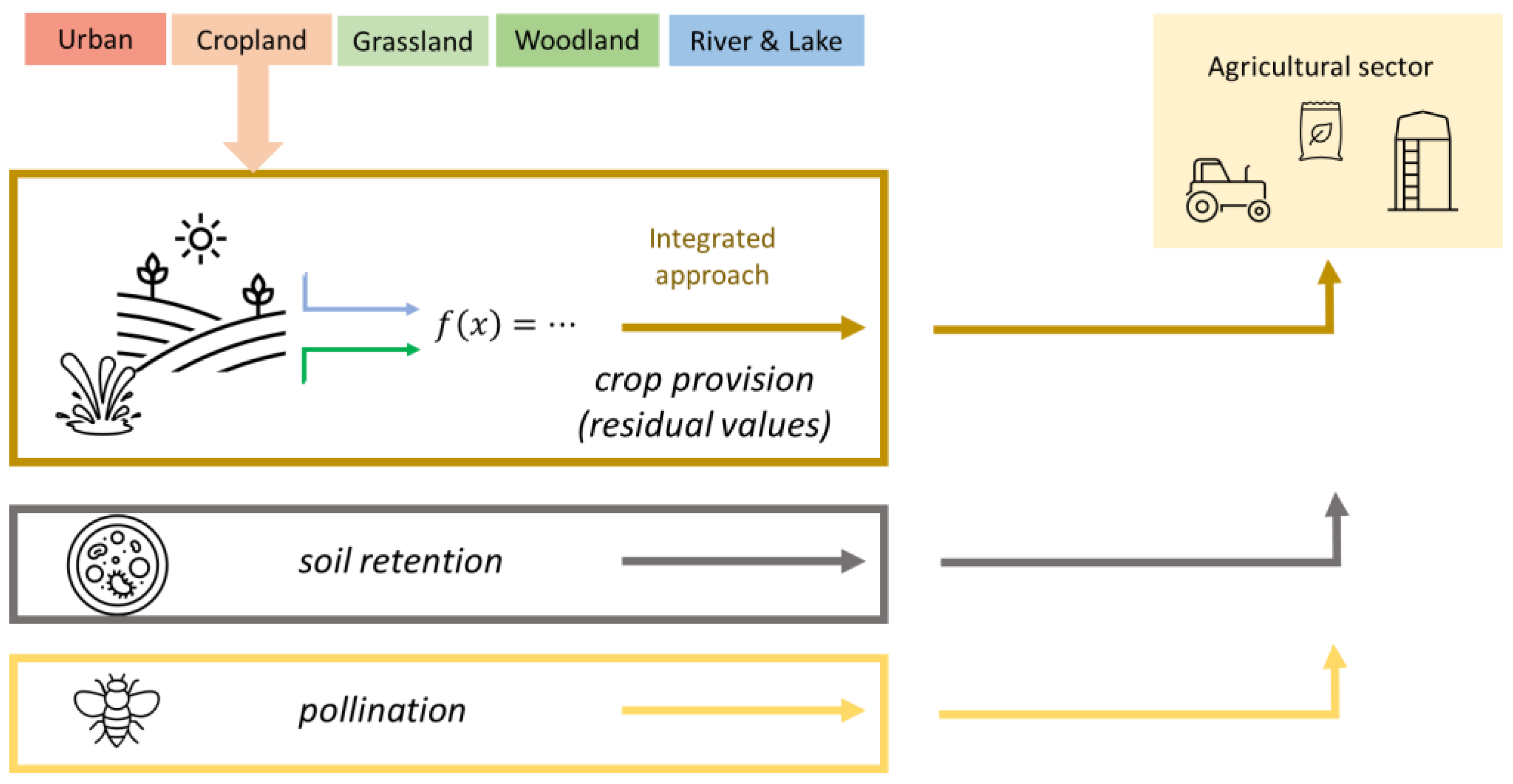
| Supply | Economic Units | Ecosystem Types | Use | Economic Unit | Ecosystem Types | ||||
|---|---|---|---|---|---|---|---|---|---|
| Cropland | Other Ecosystem Types | Total | Agriculture | Other Economic Units | Total | ||||
| Crop provision | Crop provision | ||||||||
| 2000 | 15.615 | 0 | 15.615 | 2000 | 15.615 | 0 | 15.615 | ||
| 2006 | 15.326 | 0 | 15.326 | 2006 | 15.326 | 0 | 15.326 | ||
| 2012 | 20.795 | 0 | 20.795 | 2012 | 20.795 | 0 | 20.795 | ||
| Supply | Economic Units | Ecosystem Types | Use | Economic Unit | Ecosystem Types | ||||
|---|---|---|---|---|---|---|---|---|---|
| Cropland | Other Ecosystem Types | Total | Agriculture | Other Economic Units | Total | ||||
| Crop provision | Crop provision | ||||||||
| 2000 | 8.365 | 0 | 8.365 | 2000 | 8.365 | 0 | 8.365 | ||
| 2006 | 8.119 | 0 | 8.119 | 2006 | 8.119 | 0 | 8.119 | ||
| 2012 | 11.407 | 0 | 11.407 | 2012 | 11.407 | 0 | 11.407 | ||
| Soil retention | Soil retention | ||||||||
| 2000 | 11.114 | 0 | 11.114 | 2000 | 11.114 | 0 | 11.114 | ||
| 2006 | 11.648 | 0 | 11.648 | 2006 | 11.648 | 0 | 11.648 | ||
| 2012 | 11.512 | 0 | 11.512 | 2012 | 11.512 | 0 | 11.512 | ||
| Crop pollination | Crop pollination | ||||||||
| 2000 | 4.085 | 0 | 4.085 | 2000 | 4.085 | 0 | 4.085 | ||
| 2006 | 5.235 | 0 | 5.235 | 2006 | 5.235 | 0 | 5.235 | ||
| 2012 | 4.517 | 0 | 4.517 | 2012 | 4.517 | 0 | 4.517 | ||
| Total | Total | ||||||||
| 2000 | 23.564 | 0 | 23.564 | 2000 | 23.564 | 0 | 23.564 | ||
| 2006 | 25.002 | 0 | 25.002 | 2006 | 25.002 | 0 | 25.002 | ||
| 2012 | 27.436 | 0 | 27.436 | 2012 | 27.436 | 0 | 27.436 | ||
Publisher’s Note: MDPI stays neutral with regard to jurisdictional claims in published maps and institutional affiliations. |
© 2022 by the author. Licensee MDPI, Basel, Switzerland. This article is an open access article distributed under the terms and conditions of the Creative Commons Attribution (CC BY) license (https://creativecommons.org/licenses/by/4.0/).
Share and Cite
La Notte, A. Ecologically Intermediate and Economically Final: The Role of the Ecosystem Services Framework in Measuring Sustainability in Agri-Food Systems. Land 2022, 11, 84. https://doi.org/10.3390/land11010084
La Notte A. Ecologically Intermediate and Economically Final: The Role of the Ecosystem Services Framework in Measuring Sustainability in Agri-Food Systems. Land. 2022; 11(1):84. https://doi.org/10.3390/land11010084
Chicago/Turabian StyleLa Notte, Alessandra. 2022. "Ecologically Intermediate and Economically Final: The Role of the Ecosystem Services Framework in Measuring Sustainability in Agri-Food Systems" Land 11, no. 1: 84. https://doi.org/10.3390/land11010084
APA StyleLa Notte, A. (2022). Ecologically Intermediate and Economically Final: The Role of the Ecosystem Services Framework in Measuring Sustainability in Agri-Food Systems. Land, 11(1), 84. https://doi.org/10.3390/land11010084





